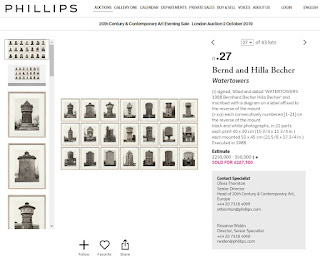Bernd and Hilla Becher
Both are artists – Hilla was a commercial photographer and Bernd was a painter. The work was produced and exhibited as art. Therefore, the wider creative intention was to produce work to be sold as art pieces. The work is personal, as it initially featured buildings and structures seen in the area around the Rhur region in Germany where they both lived. Hilla talks about the work in the video inferring she was fascinated by it to the extent where she was emotionally ‘Moved’ by the sight of the structures. Bernd talks about the connection with the buildings in terms of his family working in the mining industries and these building therefore being the backdrop to their working lives.
Having met at the Kunstakademie in Dusseldorf in 1957, they both began on a project to record the buildings and structures as they were being demolished and replaced as Germany modernised after WWII. As the project grew they moved further afield photographing similar building in other countries, France, Wales and North America.
Creative Intention – The specifics and rationale behind the project stems from the sense of place and the importance of the buildings in terms of defining the place/landscape. Bernd also speaks in the video about how integral the buildings are in terms of the economy; these were the buildings and industries that his family worked in. These were the buildings that defined, the place, the region and how people were able to make a living and prosper, so he has a close affinity with the structures. This connection with these buildings being so strong that he says…
“For us at the time we were trying to carry off these objects – I’ll call them things, but we couldn’t carry them off in their original form. By photographing them we shrank them and turned them into images”.
Bernd goes on to say there was a point where he realised that these structures were going to disappear and were of a time and place and to him seemed as significant as architecture from earlier periods that evoked aspects of another industrial age…
“For me this was an architecture just as important as medieval quarries which evoke for us the thinking of another age”.
The first collaborative photos’ were shot around 1958 using a 6cm x 9cm Linhofcamera. (2)
In terms of why this camera was used and is fit for purpose in realising their creative intentions, simply comes down to the fact that this is a pro-spec camera that produces larger negatives (Medium format). The size of the negative if used in conjunction with a high specification film e.g., one with a lower ISO would enable the prints to be produced at a very high standard suitable for use for exhibiting relatively large and subsequently sold as art pieces. You could also suggest with the 6 x 9 format it suited the compositions given that the buildings where tall and relatively thin in many instances? The other reason for using these cameras was that had the rising front standard which helps with rectifying converging verticals when shooting building from a lower viewpoint
Later they used the larger format 5x4 Plaubel view camera
This is another step up in negative size and therefore a massive increase in the potential quality. Given that one of Bernd's driving forces was to attain precision in depicting these buildings and structures this increase in negative size (Format) makes this camera fit for purpose. With the step up in size and and change of format there's additional scope for the camera being able to cope with issues around converging verticals and therefore create even more accurate recordings of the buildings/structures.
If we watch the video here at 3mins and 29 secs we see a close up of one of their prints and it includes the film rebate details and we can see that they have used APX 25...
25 iso films used on medium and large format cameras would produce ultra fine grain and ridiculously sharp images with incredible detail suitable to meet the Becher's creative intentions. The resulting prints would certainly stand up to being printed to the kind of size you see their work printed in exhibitions (See below).
“The Bechers’ purpose has always been to make the clearest possible photographs of industrial structures. They are not interested in making euphemistic, socio-romantic pictures glorifying industry, nor doom-laden spectacles showing its costs and dangers. Equally, they have nothing in common with photographers who seek to make pleasing modernist abstractions, treating the structures as decorative shapes divorced from their function.
The Bechers’ goal is to create photographs that are concentrated on the structures themselves and not qualified by subjective interpretations. To them, these structures are the ‘architecture of engineers’ and their pictures should be seen as the photography of engineers – that is, record pictures”. (10)
“They are like portraits and the devotional aspect of their work becomes apparent. Photography, like film, has two specific properties. The first is that the photograph will record far more than the eye could see at the time of exposure. It traps details so finely on the negative that it would take the naked eye a long time to uncover the same amount of information”. (10)
https://en.wikipedia.org/wiki/List_of_discontinued_photographic_films#Black_and_white_film_2
https://www.tate.org.uk/art/artists/bernd-becher-and-hilla-becher-718/who-are-bechers
https://www.youtube.com/watch?v=TY4yaJ04KuM (2)
https://www.moma.org/momaorg/shared/pdfs/docs/learn/courses/Bechers_Sonnabend.pdf
https://spruethmagers.com/artists/bernd-hilla-becher/
https://spruethmagers.com/files/bhb_aa_files_no_66_june_2013_pp_16_36.pdf
https://blog.mechanicallandscapes.com/2020/02/11/546-bernd-and-hilla-bechers-industrial-visions-at-the-national-museum-cardiff/
https://www.youtube.com/watch?v=v-1O0NxIWDc
https://www.youtube.com/watch?v=SW3MFmybRe0&t=53s
http://www.artnet.com/artists/bernd-and-hilla-becher/
https://www.tate.org.uk/art/artists/bernd-becher-and-hilla-becher-718/long-look (10)
https://www.phillips.com/detail/bernd-and-hilla-becher/UK010619/27














